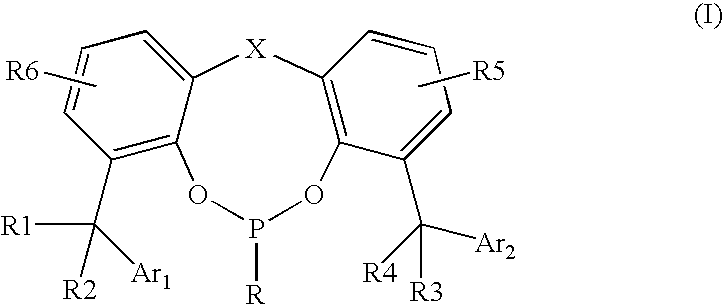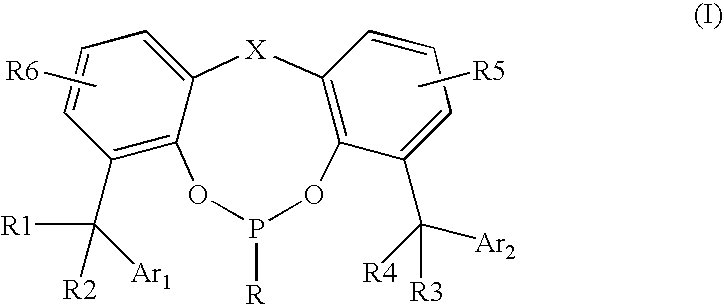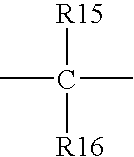Phosphonite containing catalysts for hydroformylation processes
a hydroformylation and catalyst technology, applied in the field of phosphonite compounds, can solve the problems of decomposition of ligands and degradation, and achieve the effects of increasing the activity of rh catalyst, enhancing catalyst stability, and increasing production ra
- Summary
- Abstract
- Description
- Claims
- Application Information
AI Technical Summary
Benefits of technology
Problems solved by technology
Method used
Image
Examples
examples
Synthesis of Phosphonite Ligands
[0067]Phosphonites were synthesized by reaction of phenyldicholorophosphine or alkyldicholorophosphine with corresponding substituted methylene bisphenols in the presence of triethylamine. All of the syntheses were carried out under nitrogen.
[0068]A typical procedure follows:
[0069]Methylene bisphenol (20 mmol) was mixed with triethylamine (44 mmol) in a mixed solvent (toluene:cyclohexane 2:1) and stirred. An ice-bath was applied to maintain the reaction temperature below 5° C. Then, a solution of phenyldicholorophosphine or alkyldicholorophosphine (20 mmol) in toluene (20 to 40 ml) was added slowly into the reaction mixture. After addition, the reaction was continued at 5° C. or lower for 30 min., then the temperature was raised to ambient temperature for 1 hour. The reaction was heated to 50° C. for 6 to 10 hours until complete disappearance of the starting bisphenol as shown by GC analysis. The precipitate that formed was removed by filtration, and ...
examples 7-11
Ligand B
[0095]These examples illustrate a desirable nature of phosphonite Ligand B.
[0096]Hydroformylation experiments were carried out in the same manner as Comparative Examples 4-6, except utilizing various amounts of Ligand “B”. The reaction conditions and the results of this work are presented in Table 1.
examples 12-13
Ligand C
[0097]These examples illustrate a desirable nature of phosphonite Ligand C.
[0098]Hydroformylation experiments were carried out in the same manner as Comparative Examples 4-6, except utilizing various amounts of Ligand “C”. The reaction conditions and the results of this work are presented in Table 1.
PUM
| Property | Measurement | Unit |
|---|---|---|
| pressure | aaaaa | aaaaa |
| pressure | aaaaa | aaaaa |
| concentration | aaaaa | aaaaa |
Abstract
Description
Claims
Application Information
 Login to View More
Login to View More - R&D
- Intellectual Property
- Life Sciences
- Materials
- Tech Scout
- Unparalleled Data Quality
- Higher Quality Content
- 60% Fewer Hallucinations
Browse by: Latest US Patents, China's latest patents, Technical Efficacy Thesaurus, Application Domain, Technology Topic, Popular Technical Reports.
© 2025 PatSnap. All rights reserved.Legal|Privacy policy|Modern Slavery Act Transparency Statement|Sitemap|About US| Contact US: help@patsnap.com



